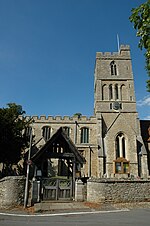Sharnbrook
Sharnbrook is a village and civil parish located in the Borough of Bedford in Bedfordshire, England, situated around 7 miles (11 km) north-west of Bedford town centre. The settlement was recorded in the Domesday Book of 1086 as a parish within the Hundred of Willey but was probably first developed in Saxon times. The oldest surviving building, St Peter's Church, is Norman. The name is believed to be derived from the Anglo Saxon word sharn meaning dung. Many of the older buildings in the village are constructed of the local oolitic limestone, also used in other traditional north Bedfordshire settlements. Situated just north of a loop in the River Great Ouse and almost due north of Bedford, the village has developed as a ribbon-settlement running south-east to north-west, with the core of the community clustered at the north-western end.
Excerpt from the Wikipedia article Sharnbrook (License: CC BY-SA 3.0, Authors).Sharnbrook
The Old Road,
Geographical coordinates (GPS) Address Nearby Places Show on map
Geographical coordinates (GPS)
| Latitude | Longitude |
|---|---|
| N 52.2166 ° | E -0.5333 ° |
Address
The Old Road
The Old Road
MK43 7JD
England, United Kingdom
Open on Google Maps







